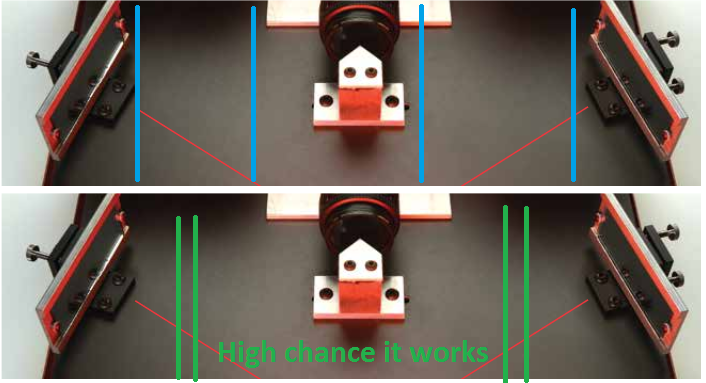This forum is disabled, please visit https://forum.opencv.org
 | 1 | initial version |
Depends on your setup, but assuming that the objects will be falling more or less in the same distance/plane with respect the mirrors/camera matrix (within the stream limited by e.g. the green lines in the picture), you can calibrate the camera easily with a two-sided chessboard (identical on each side) to determine the correspondence of pixels between between both views. Then you compare the corresponding areas - if you see only one object at one view, but two in the other, you know that you have in fact two objects overlapping. This approach will be harder to implement if the stream of objects is very wide, i.e. the distance to the camera matrix varies greatly with respect to the objects' size (e.g. blue lines in the picture).

If you also try to detect seeds, you can also try to detect overlaps by analyzing height to width ratio of the bounding box. Overlapped seeds will typically have height to width ratio that is much closer to 1. Depending on your setup, speed and dosing of falling objects, this may actually be quite accurate itself and you may not even need a second view to count accurately. This approach may work regardless of the width of the stream.
 | 2 | No.2 Revision |
Depends on your setup, but assuming that the objects will be falling more or less in the same distance/plane with respect to the mirrors/camera matrix (within the stream limited by e.g. the green lines in the picture), you can calibrate the camera easily with a two-sided chessboard (identical on each side) to determine the correspondence of pixels between between both views. Then you compare the corresponding areas - if you see only one object at one view, but two in the other, you know that you have in fact two objects overlapping. This approach will be harder to implement if the stream of objects is very wide, i.e. the distance to the camera matrix varies greatly with respect to the objects' size (e.g. blue lines in the picture).

If you also try to detect seeds, you can also try to detect overlaps by analyzing height to width ratio of the bounding box. Overlapped seeds will typically have height to width ratio that is much closer to 1. Depending on your setup, speed and dosing of falling objects, this may actually be quite accurate itself and you may not even need a second view to count accurately. This approach may work regardless of the width of the stream.